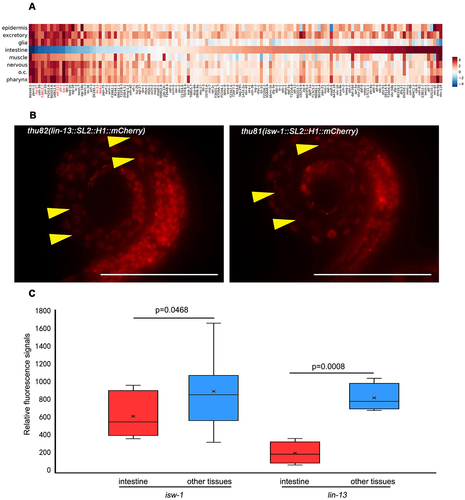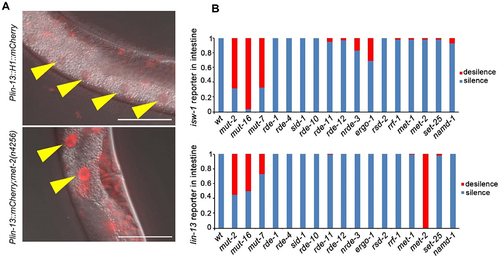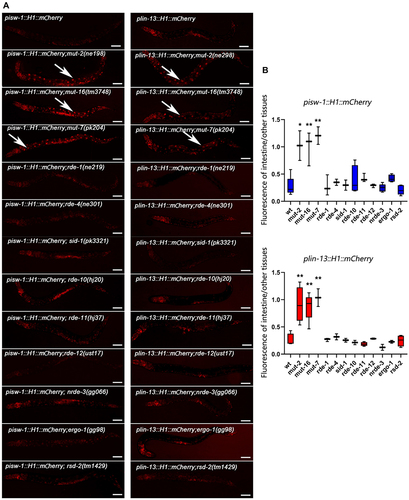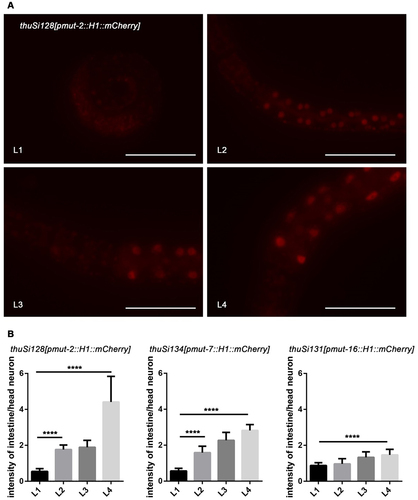Figures & data
Figure 1. The varied expression patterns of housekeeping transcription factors in transgenic and endogenous knock-in lines. (a) The tissue-level expression pattern of housekeeping genes arranged by intestine depletion scores. Each column indicates a transgenic line generated by bombardment, and each line indicates a tissue. The red marked genes are also tested by MosSCI in further study. (b) Two typical housekeeping genes expressed in all tissues of worm including intestine, when the endogenous knock-in strain was examined. The reporter lines were generated by CRISPR/Cas9, and the fluorescent mCherry sequence was inserted into the 3’ end of those genes. The worms shown here are at the L1 stage. Data were collected over three independent experiments. Yellow arrowheads indicate intestine nuclei. Scale bar, 50 μm. (c) For the knock-in strains, quantification of fluorescence signal was performed between the intestine and other tissues. Student’s t-test was applied for statistical analysis.

Table 1. The intestine silencing in multi-copy and single-copy transgene reporter lines.
Figure 2. Intestinal silenced transgenes are de-silenced by mutators and met-2. (a) lin-13 reporter line was generated by MosSCI insertion into ttTi5606 on chromosome II, and the silenced expression in the intestine was rescued by met-2 mutation. Data were collected over three independent experiments. Yellow arrowheads indicate intestinal cell nuclei. Scale bar, 50 μm. (b) the percentage of mCherry de-silenced worms in different mutants. A minimum of 20 worms were observed each strain. All the worms observed are at the L4 stage.

Figure 3. MosSCI transgenic lin-13 and isw-1 expression levels were regulated by the RNAi pathway. (a) Live worm images exhibited a differentially expressed level of reporters in the intestines of different mutant worms. (b) Relative fluorescent signals of the intestine compared to other tissues. Data were collected over three independent experiments. All worms observed are at the L4 stage. The anterior is on the left of the images. Data were collected over three independent experiments. White arrows indicate the intestine nuclei. Scale bar, 50 μm. Unpaired t-tests performed for comparisons; *, p < 0.1. **; p < 0.01.

Figure 4. Mut-2, mut-7, and mut-16 increased their expression level during the larval development. (a) Images of the anterior and partial intestine of the mut-2 reporter. From L1 to L4, strengthened intestinal expression of the single-copy transgenic reporter of mut-2 was detected, while the fluorescence intensity of head neurons was stable. Scale bar, 50 μm. (b) The relative fluorescent signal of the intestine to head neurons increased significantly. Data were collected over three independent experiments. The data are presented as mean + SEM. Unpaired t-tests performed for comparison; ****, p < 0.0001.

Supplemental Material
Download Zip (4.5 MB)Data availability statement
The authors confirm that the data supporting the findings of this study are available within the article and its supplementary materials.
